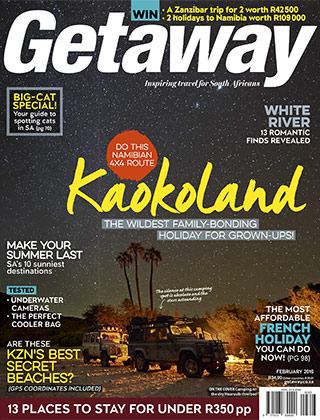Our big cats are members of Africa’s megafauna. But they are what’s left of creatures even more fantastic…
Also read: That time I fell in love with an octopus

Photo by Christoph Hoffmann.
Snuck away in the sinew of our February 2016 issue are two short sentences in one of our stories: ‘Before pine plantations were created in the drier areas, these were strongholds of the Eastern Cape lion. The last one was shot nearby just 50 years ago.’ It’s a wan statement, so matter-of-fact that, when signing off the article in which it appears, I almost – almost – glossed over it. It felt commonplace because it’s the kind of sentence we often read these days; this is becoming our world, isn’t it? The stunning thing is that it’s often a case of out of sight, out of mind: living without will simply become the new baseline of our reality.
One of my best reads ever is Feral, by The Guardian’s environmental writer George Monbiot. In it, he talks about extinct American megafauna of 10000 to 15000 years ago: my favourites are a beaver the size of a black bear with six-inch teeth, a giant sabre-toothed cat as big as a brown bear with six-foot fangs that hunted in packs, an armadillo as hefty as a small car, a nine-foot long sabre-toothed salmon and, wait for it, a ground sloth that weighed as much as an elephant and used its hooked claws to bring down whole trees. Doesn’t that sound like a spectacular world?
Writes Monbiot: ‘The evidence suggests that it was not, as many palaeontologists first supposed, climate change that wiped out the American megafauna: it had survived massive fluctuations in the recent past, and the habitats that many of the species required still exist. They were hunted to extinction.’
Africa is the only continent on which a more diverse range of megafauna still remains. Our big cats belong to this category and are one of the reasons tourists from other continents spend a lot of money coming to visit ours – fundamental to our GDP.
Of the big cats, the lion is king. It is, as Scott Ramsay writes in his conservation story on page 77, the continent’s totem animal. What would it be like if Africa were without it? This is not too great a stretch of the imagination: since 2006, 121 animals have become extinct, according to the International Union for Conservation of Nature. These things happen with hardly a blip on the world’s radar. Think about how quickly realities change: can you not remember a time when your parents laughed hilariously at the idea of selling bottled water?
We must become activists for our megafauna. I, certainly, don’t want to live in a world without them. And so we must also question statements that have been taken at face value. ‘Hunters contribute towards conservation,’ is one of them. Is it true? Read Scott Ramsay’s story on whether lion hunting has a place in Africa and make up your own mind. In the meanwhile, a good place to start an education from is by appreciating these glorious big cats – in person. Read our expert’s guide on where to find them on page 70.
I hope you enjoy this issue, packed full of great reads, deals and inspiration. With love, from us to you.
This article was first published in the February 2016 issue of Getaway magazine.
Our February issue is packed full of great holiday destinations for 2016. Get your copy today.


















